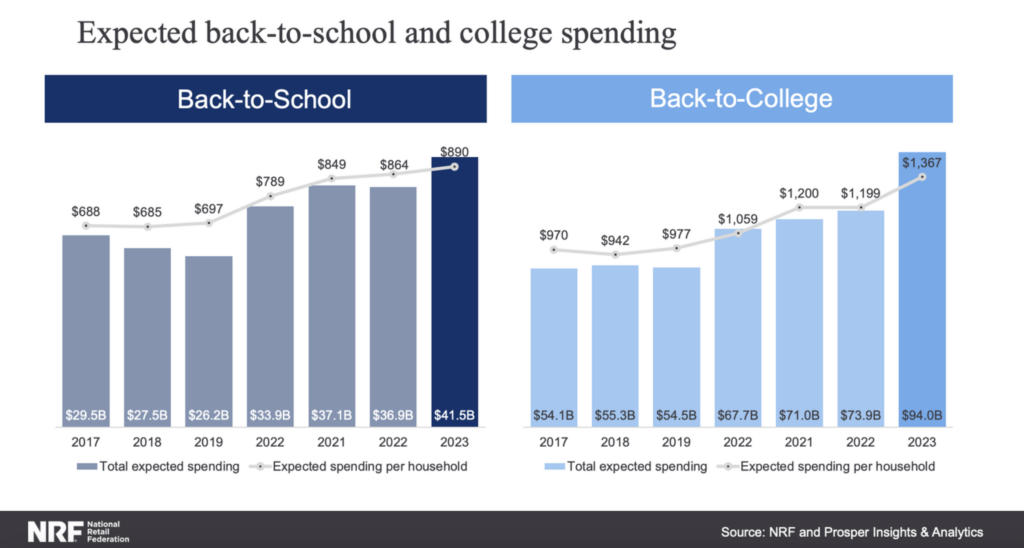By Rae Guimond, Director of Strategy and Development at PriceSpider
As summer draws to a close, swimming pools and sunny days give way to homework and hall passes. And of course, amidst the hustle and bustle of returning to the classroom comes the need for school supplies—and lots of them.
In fact, according to the National Retail Federation, the back-to-school business is booming like never before. In 2023, back-to-school spending is expected to total $41.5 billion, up from $36.9 billion in 2022 and the previous high of $37.1 billion in 2021. Not to be outdone, back-to-college spending is expected to hit $94 billion, about $20 billion more than its previous high in 2022.

But unlike the old days of fighting for folders and notebook paper in the aisles of big-box retail stores, much of today’s back-to-school shopping is happening in the digital marketplace—with 55% of back-to-school shoppers and 49% of back-to-college shoppers reporting they’re shopping online for supplies. And with next-generation shoppable media that allows customers to purchase from virtually anywhere on the internet, these numbers are only going to get bigger.
Needless to say, the back-to-school season is a crucial time for retailers, representing a massive opportunity to capitalize on seasonal spending sprees (not to mention the whims of schoolchildren and teenage trends). But in order for retailers to maximize sales and get more online traffic from all those eager shoppers, they can’t operate alone. To get more eyes on their products and more customers to checkout, retailers need to be sharing data with their brands.
To share or not to share? For smart retailers, there really is no question.
Unfortunately, somewhere along the line data sharing got a bad rap—mostly due to FUD (fear, uncertainty and doubt) that left business leaders wondering why they would take what they assumed is a major risk by sharing their data. But as more and more becomes known about the benefits of data sharing, the tide is turning on the idea of information collaboration. And if the ecommerce industry is willing to embrace a “sharing is caring” mentality around their data, brands, retailers and their customers stand to benefit greatly.
As Lydia Clougherty Jones, senior research director in Gartner’s Data and Analytics Group, noted in this MIT Sloan article, “When you share data and you’re able to generate more robust analytics and … demonstrate and drive more value, you have more involvement and potentially more influence. Data plays an enormous role in driving better relationships … with the customers.”
There’s virtually no downside to data sharing, and every party benefits from having more information – and therefore more insights – to optimize ecommerce operations.
Here are the top three reasons smart retailers are sharing data with brands:
1. Brands who can see marketing ROI are incentivized to send more traffic and recurring buyers their way.
Brands have myriad options for where to send the traffic from their ad campaigns. And when it comes to prioritizing retailer websites, they’re going to give first nod to the ones that provide them with the most visibility into marketing performance. If a retailer chooses not to share conversion data with the brands that feed them, they might as well be sending their customers into a black hole and hoping for the best, which is not the best use of a brand’s marketing dollars.
The fact is, brands need to optimize the customer journey to maximize sales. And to do that effectively, they need to be able to connect the dots from discovery to purchase. When a brand can see what assets and channels are sending high-conversion traffic to a retailer site, they’ll be far more likely to send recurring traffic your way.
From a back-to-school lens, retailers can then reap the benefits as brands prioritize sending them traffic from A) retargeting campaigns for school supplies that need to be replenished throughout the year and B) future back-to-school campaigns.
2. More knowledge means more power to unlock new audiences, drive conversions and optimize ecommerce operations on both sides.
In a market that could be described as unstable – or unpredictable at best – retailers and brands need each other. But far too often, these relationships are strained or nearly nonexistent. Why? Retailers feel like brands are competing with them more than they’re cooperating, and brands feel like retailers aren’t giving them the individual attention they deserve.
But sharing back-to-school data (and ecommerce data, in general) helps retailers and brands alike optimize their presence on the digital shelf. Whether it’s identifying technical problems (i.e. broken links), improving product pages or identifying customer trends and patterns, there’s something for both parties to gain by eliminating information asymmetry and combining insights to win more customers and optimize the path to purchase.
3. Detailed insights into the entire customer journey benefit everyone – including the customer.
Sharing data with brands doesn’t require any extra work on a retailer’s part, but it does give them access to new insights they wouldn’t otherwise have. Retailers who embrace data sharing get reports that show how much traffic brands are sending them, where it’s coming from, how many transactions are occurring as a result and which SKUs are generating the traffic that converts.
From that data, retailers can figure out which brands are prioritizing their relationship and which products are bringing people to their sites. In turn, brands can make informed business decisions with insight into the complete buyer journey – including purchase intent and conversions – from first impression to final sale. Why’s that important? From this data sharing setup, brands and retailers now have the opportunity to optimize the shopping experience and their four Ps across the digital shelf—and that means more customers, more conversions and you guessed it … more profits for both.
About the author

Rae Marie Guimond is the director of strategy and business development at PriceSpider. With more than 20 years of experience in B2B, B2C, DTC and CPG e-commerce, Guimond is dedicated to helping brands worldwide optimize the digital shelf and omnichannel shopper experiences. She works to combine technology innovation, analytics, insights and strategies to drive conversion and loyalty. Rae is known for her commitment to team and individual success, plus her passion for mentoring and fostering inclusive work environments.
A version of this article originally appeared on RetailLeader.com.

